High-Resolution Inversion Method for the Snow Water Equivalent Based on the GF-3 Satellite and Optimized EQeau Model
Abstract
1. Introduction
2. Study Area and Data
2.1. Overview of the Study Area
2.2. GF-3 Image Data
2.3. Field Measurement Data
2.4. Other Data
3. Methodology
3.1. Research Design
3.2. EQeau Model
3.3. Optimization of the Model
3.3.1. Classification of Underlying Surface Types
3.3.2. Singh–Cloude Three-Component Hybrid Decomposition (S3H Decomposition)
4. Results
4.1. Optimization of Snow Thermal Resistance Fitting
4.2. S3H Decomposition’s Snow Density Extraction Results
4.3. Results of the Optimized EQeau Model’s Extraction of Snow Water Equivalent
5. Discussion
5.1. Evaluation of Model Accuracy
5.2. Effect of the Number of Fitted Points on the Accuracy of the Model
5.3. Uncertainty and Outlook
6. Conclusions
Author Contributions
Funding
Data Availability Statement
Conflicts of Interest
References
- Pulliainen, J.; Luojus, K.; Derksen, C.; Mudryk, L.; Lemmetyinen, J.; Salminen, M.; Ikonen, J.; Takala, M.; Cohen, J.; Smolander, T. Patterns and trends of Northern Hemisphere snow mass from 1980 to 2018. Nature 2020, 581, 294–298. [Google Scholar] [CrossRef] [PubMed]
- Robinson, D.A. Monitoring northern hemisphere snow cover. Glaciol. Data Rep. 1993, 25, 1–25. [Google Scholar]
- Jonas, T.; Marty, C.; Magnusson, J. Estimating the snow water equivalent from snow depth measurements in the Swiss Alps. J. Hydrol. 2009, 378, 161–167. [Google Scholar] [CrossRef]
- Kuraś, P.K.; Weiler, M.; Alila, Y. The spatiotemporal variability of runoff generation and groundwater dynamics in a snow-dominated catchment. J. Hydrol. 2008, 352, 50–66. [Google Scholar] [CrossRef]
- Tanasienko, A.; Yakutina, O.; Chumbaev, A. Effect of snow amount on runoff, soil loss and suspended sediment during periods of snowmelt in southern West Siberia. Catena 2011, 87, 45–51. [Google Scholar] [CrossRef]
- Zhang, Y.; Ma, N. Spatiotemporal variability of snow cover and snow water equivalent in the last three decades over Eurasia. J. Hydrol. 2018, 559, 238–251. [Google Scholar] [CrossRef]
- Dozier, J.; Bair, E.H.; Davis, R.E. Estimating the spatial distribution of snow water equivalent in the world’s mountains. Wiley Interdiscip. Rev. Water 2016, 3, 461–474. [Google Scholar] [CrossRef]
- Schöne, T.; Zech, C.; Unger-Shayesteh, K.; Rudenko, V.; Thoss, H.; Wetzel, H.-U.; Gafurov, A.; Illigner, J.; Zubovich, A. A new permanent multi-parameter monitoring network in Central Asian high mountains–from measurements to data bases. Geosci. Instrum. Methods Data Syst. 2013, 2, 97–111. [Google Scholar] [CrossRef]
- Fassnacht, S.; Dressler, K.; Bales, R. Snow water equivalent interpolation for the Colorado River Basin from snow telemetry (SNOTEL) data. Water Resour. Res. 2003, 39, 1208. [Google Scholar] [CrossRef]
- Rice, R.; Bales, R.C.; Painter, T.H.; Dozier, J. Snow water equivalent along elevation gradients in the Merced and Tuolumne River basins of the Sierra Nevada. Water Resour. Res. 2011, 47, W08515. [Google Scholar] [CrossRef]
- Rittger, K.; Bair, E.H.; Kahl, A.; Dozier, J. Spatial estimates of snow water equivalent from reconstruction. Adv. Water Resour. 2016, 94, 345–363. [Google Scholar] [CrossRef]
- Serreze, M.C.; Clark, M.P.; Armstrong, R.L.; McGinnis, D.A.; Pulwarty, R.S. Characteristics of the western United States snowpack from snowpack telemetry (SNOTEL) data. Water Resour. Res. 1999, 35, 2145–2160. [Google Scholar] [CrossRef]
- Romanov, P.; Tarpley, D. Enhanced algorithm for estimating snow depth from geostationary satellites. Remote Sens. Environ. 2007, 108, 97–110. [Google Scholar] [CrossRef]
- Bair, E.H.; Abreu Calfa, A.; Rittger, K.; Dozier, J. Using machine learning for real-time estimates of snow water equivalent in the watersheds of Afghanistan. Cryosphere 2018, 12, 1579–1594. [Google Scholar] [CrossRef]
- Jiang, L.; Yang, J.; Zhang, C.; Wu, S.; Li, Z.; Dai, L.; Li, X.; Qiu, Y. Daily snow water equivalent product with SMMR, SSM/I and SSMIS from 1980 to 2020 over China. Big Earth Data 2022, 1–15. [Google Scholar] [CrossRef]
- Sun, Z.; Shi, J. Development of snow depth and snow water equivalent algorithm in Western China using passive microwave remote sensing data. Adv. Earth Sci. 2006, 21, 1363. [Google Scholar]
- Chang, A.T.; Foster, J.L.; Hall, D.K. Nimbus-7 SMMR derived global snow cover parameters. Ann. Glaciol. 1987, 9, 39–44. [Google Scholar] [CrossRef]
- Singh, G.; Verma, A.; Kumar, S.; Ganju, A.; Yamaguchi, Y.; Kulkarni, A.V. Snowpack density retrieval using fully polarimetric TerraSAR-X data in the Himalayas. IEEE Trans. Geosci. Remote Sens. 2017, 55, 6320–6329. [Google Scholar] [CrossRef]
- Shi, J. Estimation of snow water equivalence with two Ku-band dual polarization radar. In Proceedings of the IGARSS 2004 IEEE International Geoscience and Remote Sensing Symposium, Anchorage, AK, USA, 20–24 September 2004; pp. 1649–1652. [Google Scholar]
- Shi, J. Snow water equivalence retrieval using X and Ku band dual-polarization radar. In Proceedings of the 2006 IEEE International Symposium on Geoscience and Remote Sensing, Denver, CO, USA, 31 July–4 August 2006; pp. 2183–2185. [Google Scholar]
- Shi, J.; Dozier, J. Estimation of snow water equivalence using SIR-C/X-SAR. I. Inferring snow density and subsurface properties. IEEE Trans. Geosci. Remote Sens. 2000, 38, 2465–2474. [Google Scholar]
- Largeron, C.; Dumont, M.; Morin, S.; Boone, A.; Lafaysse, M.; Metref, S.; Cosme, E.; Jonas, T.; Winstral, A.; Margulis, S.A. Toward Snow Cover Estimation in Mountainous Areas Using Modern Data Assimilation Methods: A Review. Front. Earth Sci. 2020, 8, 325. [Google Scholar] [CrossRef]
- Massonnet, D.; Feigl, K.L. Radar interferometry and its application to changes in the Earth’s surface. Rev. Geophys. 1998, 36, 441–500. [Google Scholar] [CrossRef]
- Dagurov, P.; Chimitdorzhiev, T.; Dmitriev, A.; Dobrynin, S. Estimation of snow water equivalent from L-band radar interferometry: Simulation and experiment. Int. J. Remote Sens. 2020, 41, 9328–9359. [Google Scholar] [CrossRef]
- Deeb, E.J.; Forster, R.R.; Kane, D.L. Monitoring snowpack evolution using interferometric synthetic aperture radar on the North Slope of Alaska, USA. Int. J. Remote Sens. 2011, 32, 3985–4003. [Google Scholar] [CrossRef]
- Leinss, S.; Wiesmann, A.; Lemmetyinen, J.; Hajnsek, I. Snow water equivalent of dry snow measured by differential interferometry. IEEE J. Sel. Top. Appl. Earth Obs. Remote Sens. 2015, 8, 3773–3790. [Google Scholar] [CrossRef]
- Bernier, M.; Fortin, J.P.; Gauthier, Y.; Gauthier, R.; Roy, R.; Vincent, P. Determination of snow water equivalent using RADARSAT SAR data in eastern Canada. Hydrol. Processes 1999, 13, 3041–3051. [Google Scholar] [CrossRef]
- Corbane, C.; Somma, J.; Bernier, M.; Fortin, J.; Gauthier, Y.; Dedieu, J. Estimation de L’équivalent en Eau du Couvert Nival en Montagne Libanaise à Partir des Images RADARSAT-1/Estimation of Water Equivalent of the Snow Cover in Lebanese Mountains by Means of RADARSAT-1 Images. Hydrol. Sci. J. 2005, 50, 370. [Google Scholar] [CrossRef]
- Wang, Z.; Feng, X.; Xiao, P.; He, G. Retrieval of snow water equivalence using SAR data for mountainous area. J. Nanjing Univ. (Nat. Sci.) 2015, 51, 996–1004. [Google Scholar]
- Zhu, X.; Gu, L.; Ren, R.; He, F. Snow water equivalent retrieval algorithm in Jilin Province of China based on multi-temporal Sentinel-1 data. In Proceedings of the Earth Observing Systems XXIV, San Diego, CA, USA, 9 September 2019; pp. 510–518. [Google Scholar]
- Chokmani, K.; Bernier, M.; Gauthier, Y. Uncertainty analysis of EQeau, a remote sensing based model for snow water equivalent estimation. Int. J. Remote Sens. 2006, 27, 4337–4346. [Google Scholar] [CrossRef]
- Morena, L.; James, K.; Beck, J. An introduction to the RADARSAT-2 mission. Can. J. Remote Sens. 2004, 30, 221–234. [Google Scholar] [CrossRef]
- Torres, R.; Snoeij, P.; Geudtner, D.; Bibby, D.; Davidson, M.; Attema, E.; Potin, P.; Rommen, B.; Floury, N.; Brown, M. GMES Sentinel-1 mission. Remote Sens. Environ. 2012, 120, 9–24. [Google Scholar] [CrossRef]
- Zhen, L.; Bangsen, T.; Ping, Z.; Changjun, Z.; Guangde, S.; Chang, L. Overview of the snow parameters inversion from synthetic aperture radar. Nanjing Xinxi Gongcheng Daxue Xuebao 2020, 12, 159–169. [Google Scholar]
- Chen, L.; Letu, H.; Fan, M.; Shang, H.; Tao, J.; Wu, L.; Zhang, Y.; Yu, C.; Gu, J.; Zhang, N. An Introduction to the Chinese High-Resolution Earth Observation System: Gaofen-1~ 7 Civilian Satellites. J. Remote Sens. 2022, 2022, 9769536. [Google Scholar] [CrossRef]
- Shen, Y.; Wang, G.; Su, H.-C.; Han, P.; Gao, Q.-Z.; Wang, S.-D. Hydrological processes responding to climate warming in the upper reaches of Kelan River Basin with snow-dominated of the Altay Mountains region, Xinjiang. J. Glaciol. Geocryol. 2007, 29, 845–854. [Google Scholar]
- Qiu-Xiang, W. The changing tendency on the depth and days of snow cover in northern Xinjiang. Adv. Clim. Change Res. 2009, 5, 39. [Google Scholar]
- Shen, Y.; Su, H.; Wang, G.; Mao, W.; Wang, S.; Han, P.; Wang, N.; Li, Z. The Responses of Glaciers and Snow Cover to Climate Change in Xinjiang (II): Hazards Effects. J. Glaciol. Geocryol. 2013, 35, 1355–1370. [Google Scholar]
- He, B.; Wang, G.; Su, H.; Shen, Y. Response of Extreme Hydrological Events to Climate Change in the Regions of Altay Mountains, Xinjiang. J. Glaciol. Geocryol. 2012, 34, 927–933. [Google Scholar]
- Chang, Y.; Li, P.; Yang, J.; Zhao, J.; Zhao, L.; Shi, L. Polarimetric calibration and quality assessment of the GF-3 satellite images. Sensors 2018, 18, 403. [Google Scholar] [CrossRef]
- Yang, J.; Huang, X. The 30 m annual land cover dataset and its dynamics in China from 1990 to 2019. Earth Syst. Sci. Data 2021, 13, 3907–3925. [Google Scholar] [CrossRef]
- Raudkivi, A.J. Hydrology: An Advanced Introduction to Hydrological Processes and Modelling; Elsevier: Amsterdam, The Netherlands, 2013. [Google Scholar]
- Topp, G.C.; Davis, J.; Annan, A.P. Electromagnetic determination of soil water content: Measurements in coaxial transmission lines. Water Resour. Res. 1980, 16, 574–582. [Google Scholar] [CrossRef]
- Tao, H.; Chen, Q.; Li, Z.; Zeng, J.; Chen, X. Improvement of soil surface roughness measurement accuracy by close-range photogrammetry. Trans. Chin. Soc. Agric. Eng. 2017, 33, 162–167. [Google Scholar]
- Li, X.; Cai, X.; Song, Y. Research of the distribution of national scale surface roughness length with high resolution in China. Plateau Meteorol. 2014, 33, 474–482. [Google Scholar]
- Western, A.W.; Grayson, R.B.; Blöschl, G.; Willgoose, G.R.; McMahon, T.A. Observed spatial organization of soil moisture and its relation to terrain indices. Water Resour. Res. 1999, 35, 797–810. [Google Scholar] [CrossRef]
- Gómez-Plaza, A.; Martınez-Mena, M.; Albaladejo, J.; Castillo, V. Factors regulating spatial distribution of soil water content in small semiarid catchments. J. Hydrol. 2001, 253, 211–226. [Google Scholar] [CrossRef]
- Patil, A.; Singh, G.; Rüdiger, C. A novel approach for the retrieval of snow water equivalent using SAR data. In Proceedings of the IGARSS 2019-2019 IEEE International Geoscience and Remote Sensing Symposium, Yokohama, Japan, 28 July–2 August 2019; pp. 3233–3236. [Google Scholar]
- Cloude, S. Polarisation: Applications in Remote Sensing; OUP Oxford: Oxford, UK, 2009. [Google Scholar]
- Yamaguchi, Y.; Sato, A.; Boerner, W.-M.; Sato, R.; Yamada, H. Four-component scattering power decomposition with rotation of coherency matrix. IEEE Trans. Geosci. Remote Sens. 2011, 49, 2251–2258. [Google Scholar] [CrossRef]
- Varade, D.; Manickam, S.; Dikshit, O.; Singh, G. Modelling of early winter snow density using fully polarimetric C-band SAR data in the Indian Himalayas. Remote Sens. Environ. 2020, 240, 111699. [Google Scholar] [CrossRef]
- Singh, G.; Yamaguchi, Y.; Park, S.-E.; Cui, Y.; Kobayashi, H. Hybrid Freeman/eigenvalue decomposition method with extended volume scattering model. IEEE Geosci. Remote Sens. Lett. 2012, 10, 81–85. [Google Scholar] [CrossRef]
- Matzler, C. Microwave permittivity of dry snow. IEEE Trans. Geosci. Remote Sens. 1996, 34, 573–581. [Google Scholar] [CrossRef]
- Wang, Z. Retrieval of Snow Water Equivalence Using SAR Data for Typical Area of Manas River Basin in Xinjiang, China. Ph.D. Dissertation, Nanjing University, Nanjing, China, 2014. [Google Scholar]
- Conde, V.; Nico, G.; Mateus, P.; Catalão, J.; Kontu, A.; Gritsevich, M. On the estimation of temporal changes of snow water equivalent by spaceborne SAR interferometry: A new application for the Sentinel-1 mission. J. Hydrol. Hydromech. 2019, 1, 93–100. [Google Scholar] [CrossRef]
- Patil, A.; Singh, G.; Rüdiger, C. Retrieval of snow depth and snow water equivalent using dual polarization SAR data. Remote Sens. 2020, 12, 1183. [Google Scholar] [CrossRef]
- Santi, E.; Brogioni, M.; Leduc-Leballeur, M.; Macelloni, G.; Montomoli, F.; Pampaloni, P.; Lemmetyinen, J.; Cohen, J.; Rott, H.; Nagler, T. Exploiting the ANN potential in estimating snow depth and snow water equivalent from the airborne SnowSAR data at X-and Ku-bands. IEEE Trans. Geosci. Remote Sens. 2021, 60, 4301216. [Google Scholar] [CrossRef]
- Turcotte, R.; Fortin, J.-P.; Bernier, M.; Gauthier, Y. Developments for Snowpack Water Equivalent Monitoring Using Radarsat Data as Input to the Hydrotel Hydrological Model; Iahs Publication: Wallingford, UK, 2001; pp. 374–378. [Google Scholar]
- Gauthier, Y.; Bernier, M.; Fortin, J.-P.; Gauthier, R.; Roy, R.; Vincent, P. Operational Determination of Snow Water Equivalent Using Radarsat Data over a Large Hydroelectric Complex in Eastern Canada; Iahs Publication: Wallingford, UK, 2001; pp. 343–348. [Google Scholar]
- Fang, S.; Da Xu, L.; Zhu, Y.; Ahati, J.; Pei, H.; Yan, J.; Liu, Z. An integrated system for regional environmental monitoring and management based on internet of things. IEEE Trans. Ind. Inform. 2014, 10, 1596–1605. [Google Scholar] [CrossRef]
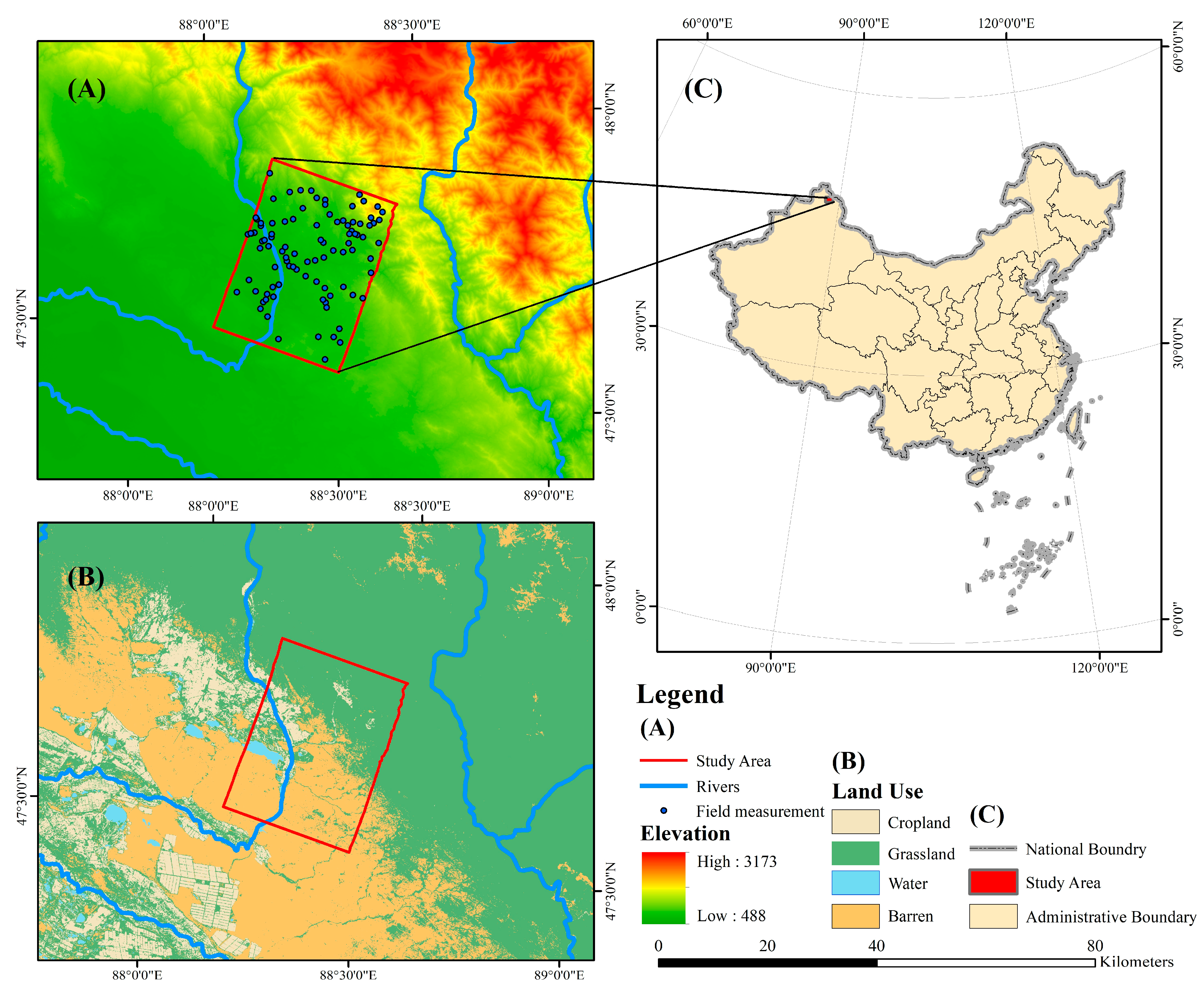
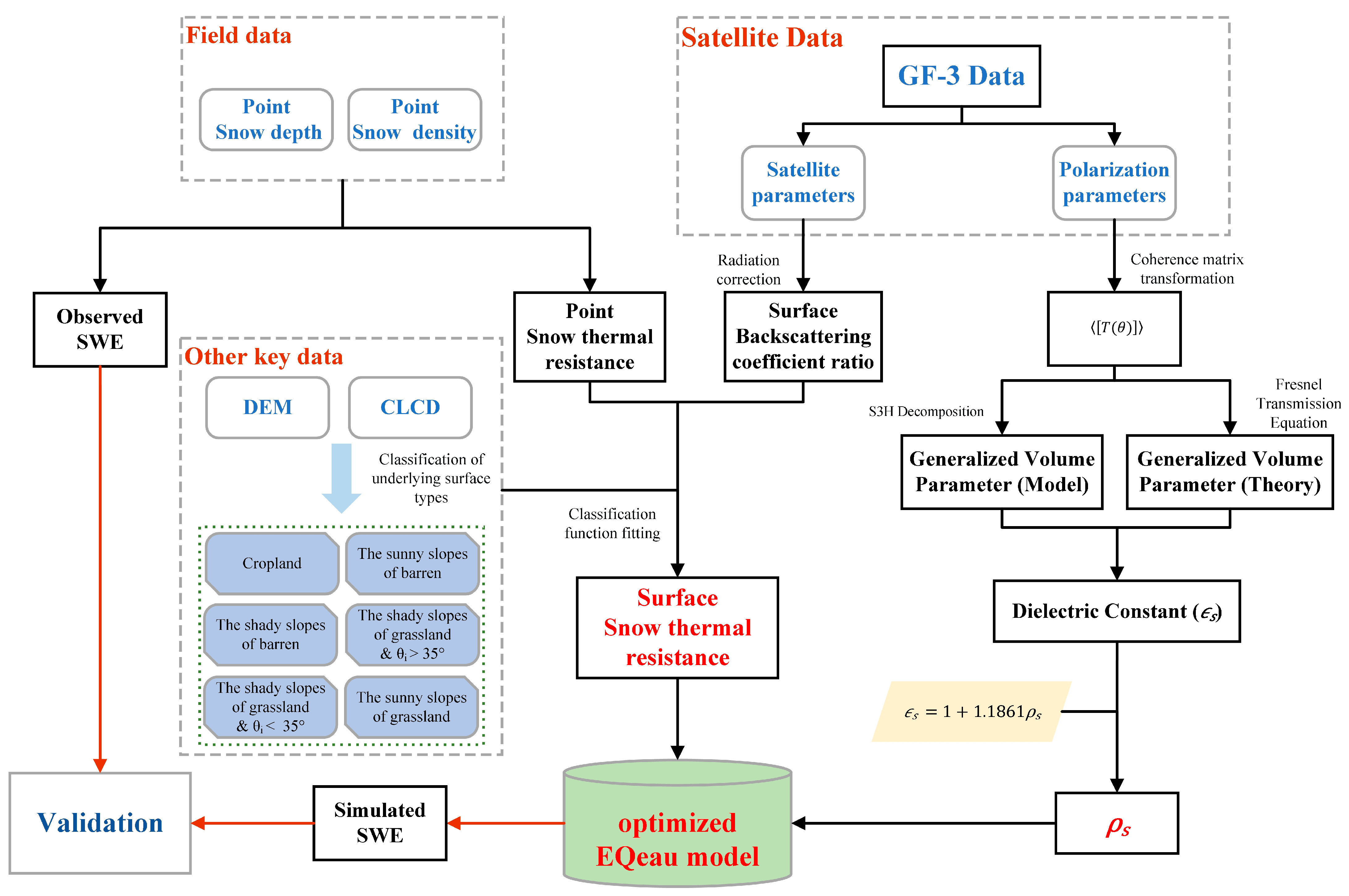
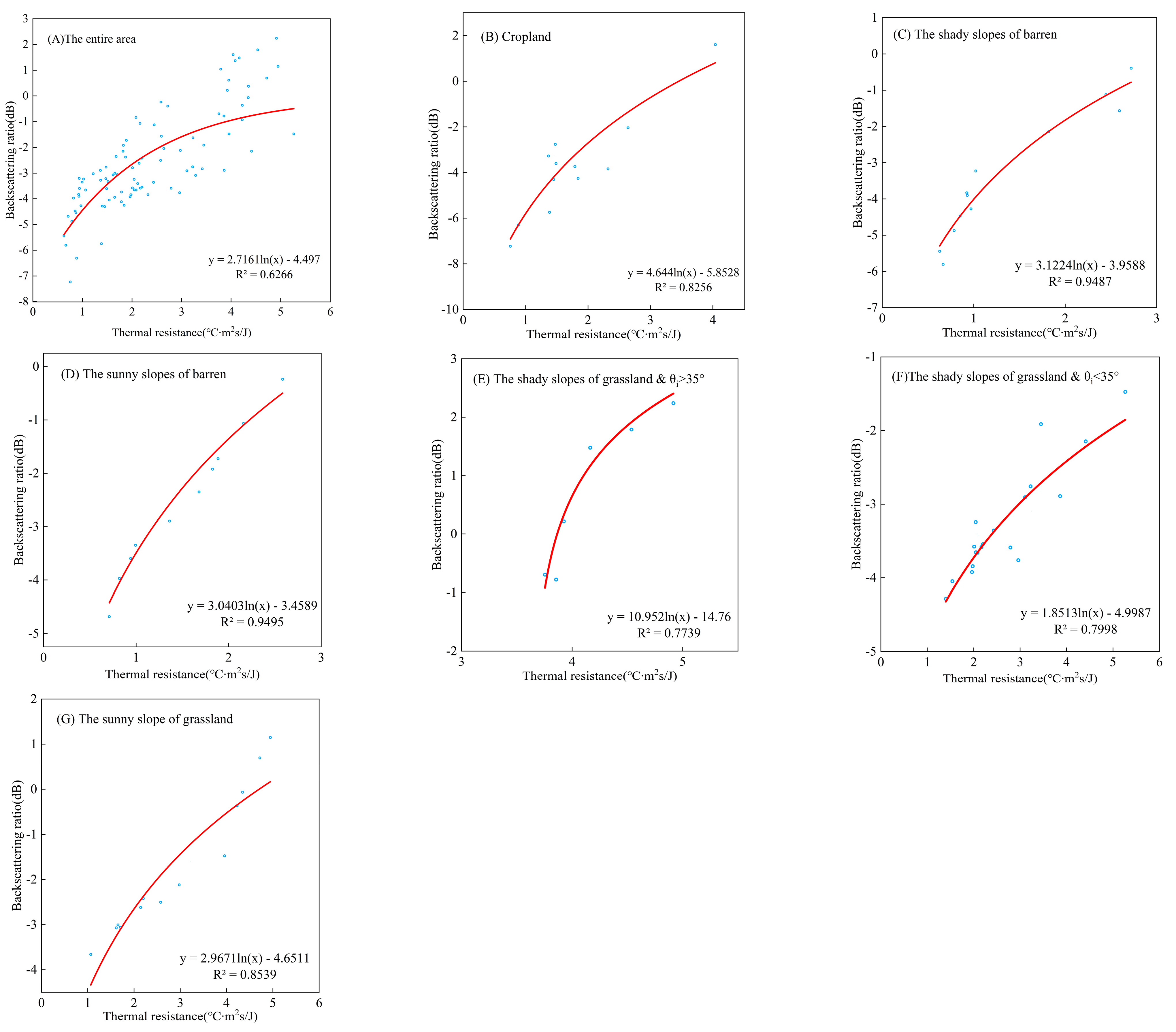
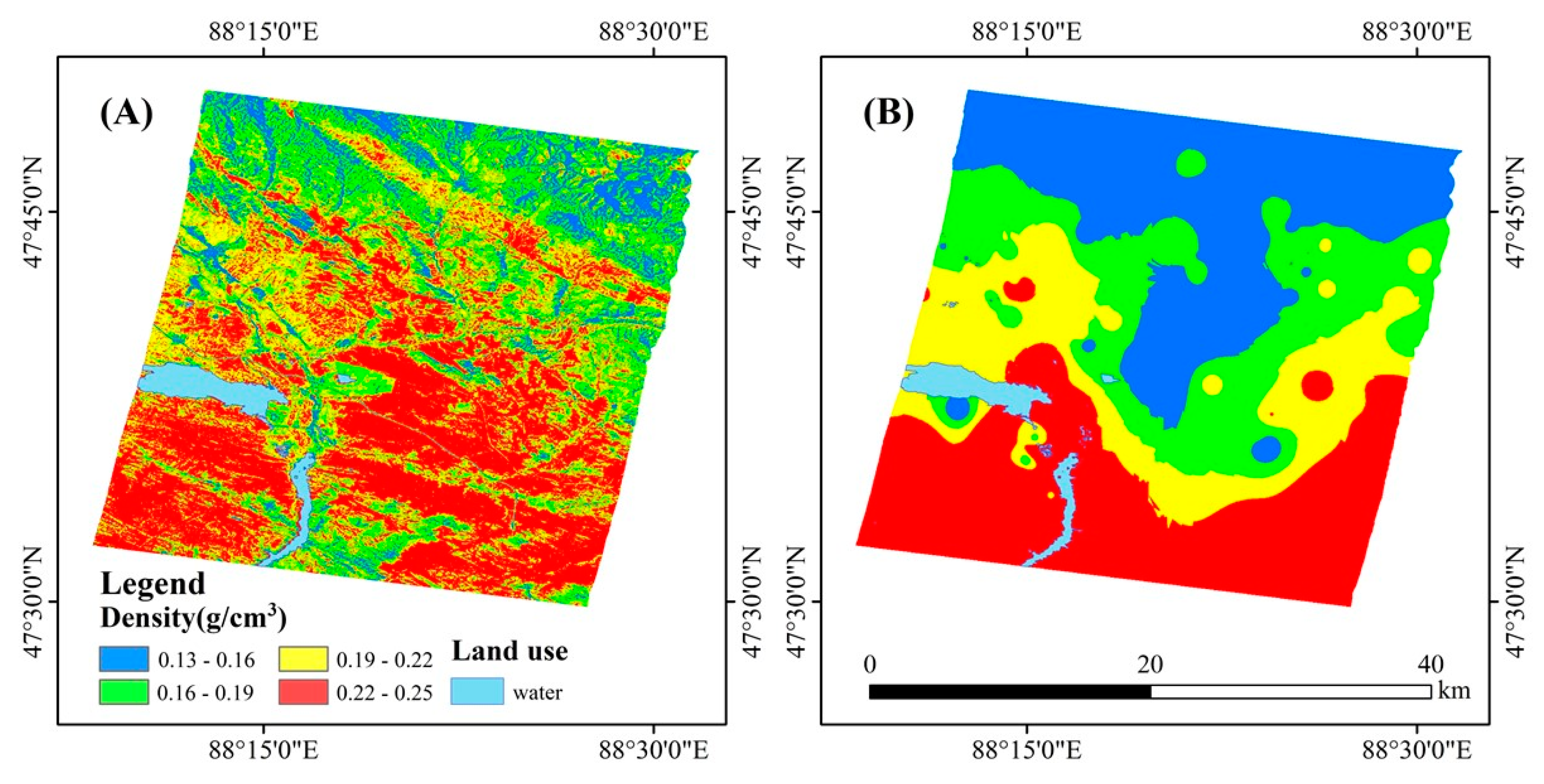


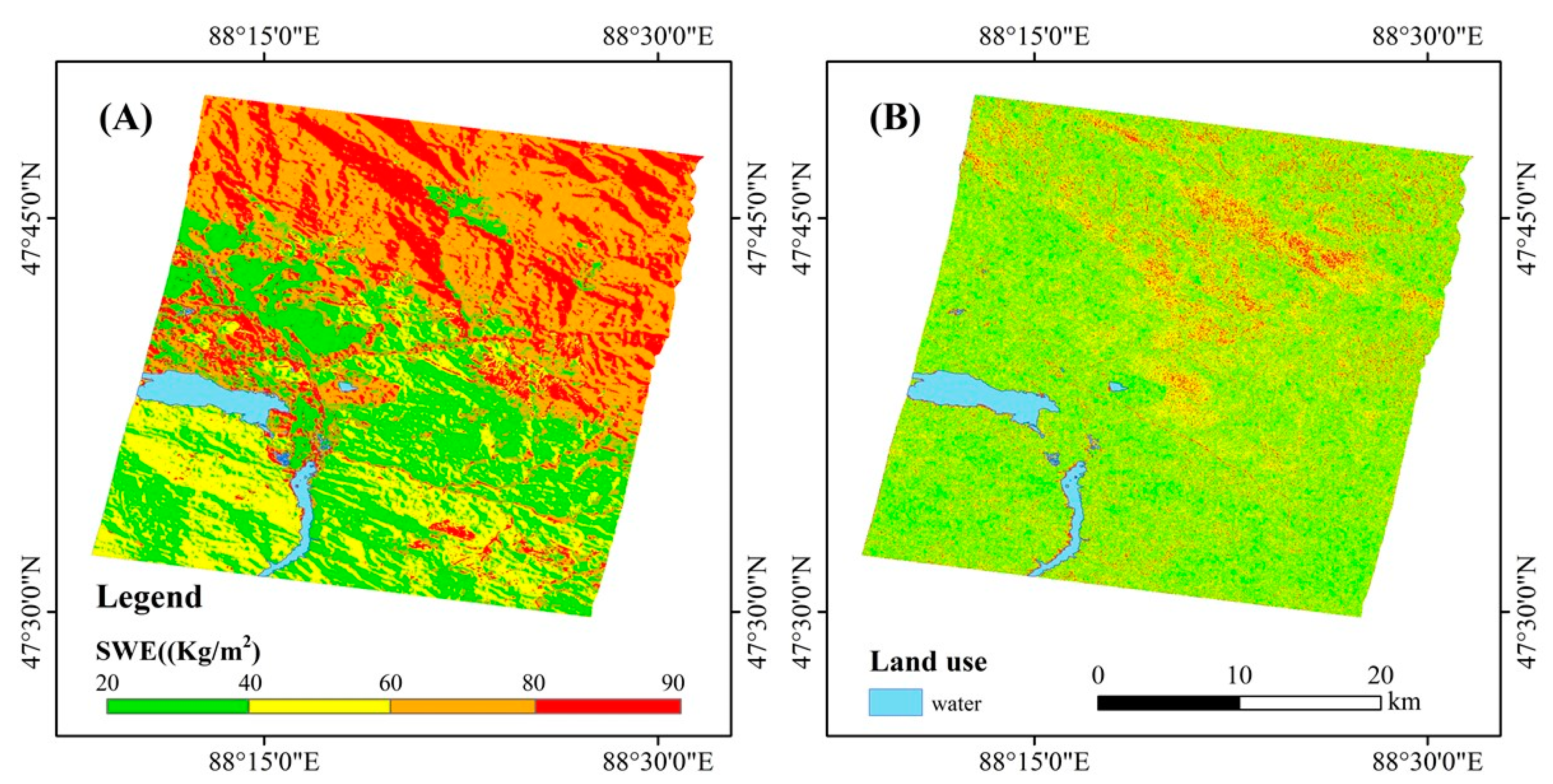
| Date | Imaging Mode | Polarization | Pixel Size/m | Incidence Angle (°) | Longitude of the Center Point (°) | Latitude of the Center Point (°) |
|---|---|---|---|---|---|---|
| 2022/2/28 | QPSI | HH/HV/VV/VH | 2.25×5.54 | 35.99 | 88.375952 | 47.652896 |
| 2021/11/04 | QPSI | HH/HV/VV/VH | 2.25×5.54 | 35.99 | 88.297601 | 47.672924 |
| Number of Measurement Points | Minimum Snow Density (kg/m3) | Maximum Snow Density (kg/m3) | Average Snow Density (kg/m3) | Minimum Snow Depth (m) | Maximum Snow Depth (m) | Average Snow Depth (m) |
|---|---|---|---|---|---|---|
| 93 | 138 | 245 | 187 | 0.107 | 0.43 | 0.249 |
| Land Category | Number of Fitting Samples | Number of Validation Samples | Total Number |
|---|---|---|---|
| Cropland | 12 | 3 | 15 |
| The shady slopes of barren | 12 | 3 | 15 |
| The sunny slopes of barren | 12 | 2 | 14 |
| 6 | 2 | 8 | |
| 19 | 5 | 24 | |
| The sunny slopes of grassland | 13 | 4 | 17 |
| Land Category | RMSE (dB) | ||
|---|---|---|---|
| Cropland | 0.722 | 4.644 | −5.8528 |
| The shady slopes of barren | 0.297 | 3.1224 | −3.9588 |
| The sunny slopes of barren | 0.430 | 3.0403 | −3.4589 |
| 0.562 | 10.952 | −14.76 | |
| 0.195 | 1.8513 | −4.9987 | |
| The sunny slopes of grassland | 0.567 | 2.9671 | −4.6511 |
| Land Category | RMSE (mm) | MAE (mm) | MRE |
|---|---|---|---|
| Overall | 5.76 | 4.89 | 10.3% |
| Cropland | 6.16 | 4.77 | 9.7% |
| The shady slopes of barren | 4.27 | 3.48 | 9.3% |
| The sunny slopes of barren | 4.42 | 3.74 | 9.2% |
| 3.76 | 3.50 | 6.5% | |
| 7.09 | 6.38 | 12.3% | |
| The sunny slopes of grassland | 6.18 | 5.47 | 11.3% |
| Land Category | RMSE (mm) | MAE (mm) | MRE |
|---|---|---|---|
| Overall | 12.05 | 12.89 | 27.4% |
| Cropland | 12.21 | 12.21 | 26.8% |
| The shady slopes of barren | 13.30 | 12.90 | 35.0% |
| The sunny slopes of barren | 12.06 | 11.31 | 28.0% |
| 12.81 | 10.55 | 18.1% | |
| 17.09 | 14.61 | 27.1% | |
| The sunny slopes of grassland | 13.69 | 13.18 | 16.8% |
| Researcher—Time | The Average RMSE (mm) |
|---|---|
| Patil—2019 [48] | 160 |
| Conde—2019 [55] | 5.3 |
| Singh—2020 [56] | 42.95 |
| Santi—2021 [57] | 34.8 |
| Proportion | Land Category | Number of Fitting Samples | Number of Validation Samples | MRE |
|---|---|---|---|---|
| 6:4 | Overall | 55 | 38 | 13.2% |
| Cropland | 9 | 6 | 11.2% | |
| The shady slopes of barren | 9 | 6 | 13.4% | |
| The sunny slopes of barren | 9 | 5 | 12.6% | |
| 4 | 4 | 9.7% | ||
| 14 | 10 | 16.8% | ||
| The sunny slopes of grassland | 10 | 7 | 15.7% | |
| 7:3 | Overall | 65 | 28 | 11.7% |
| Cropland | 10 | 5 | 10.8% | |
| The shady slopes of barren | 10 | 5 | 10.6% | |
| The sunny slopes of barren | 10 | 4 | 10.3% | |
| 5 | 3 | 8.6% | ||
| 17 | 7 | 14.1% | ||
| The sunny slopes of grassland | 12 | 5 | 12.8% |
Publisher’s Note: MDPI stays neutral with regard to jurisdictional claims in published maps and institutional affiliations. |
© 2022 by the authors. Licensee MDPI, Basel, Switzerland. This article is an open access article distributed under the terms and conditions of the Creative Commons Attribution (CC BY) license (https://creativecommons.org/licenses/by/4.0/).
Share and Cite
Yang, Y.; Fang, S.; Wu, H.; Du, J.; Wang, X.; Chen, R.; Liu, Y.; Wang, H. High-Resolution Inversion Method for the Snow Water Equivalent Based on the GF-3 Satellite and Optimized EQeau Model. Remote Sens. 2022, 14, 4931. https://doi.org/10.3390/rs14194931
Yang Y, Fang S, Wu H, Du J, Wang X, Chen R, Liu Y, Wang H. High-Resolution Inversion Method for the Snow Water Equivalent Based on the GF-3 Satellite and Optimized EQeau Model. Remote Sensing. 2022; 14(19):4931. https://doi.org/10.3390/rs14194931
Chicago/Turabian StyleYang, Yichen, Shifeng Fang, Hua Wu, Jiaqiang Du, Xiaohu Wang, Rensheng Chen, Yongqiang Liu, and Hao Wang. 2022. "High-Resolution Inversion Method for the Snow Water Equivalent Based on the GF-3 Satellite and Optimized EQeau Model" Remote Sensing 14, no. 19: 4931. https://doi.org/10.3390/rs14194931
APA StyleYang, Y., Fang, S., Wu, H., Du, J., Wang, X., Chen, R., Liu, Y., & Wang, H. (2022). High-Resolution Inversion Method for the Snow Water Equivalent Based on the GF-3 Satellite and Optimized EQeau Model. Remote Sensing, 14(19), 4931. https://doi.org/10.3390/rs14194931






